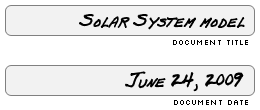Sun size (in meters):
Back in my days at college, I was an art student, which means that my final exams were actually final art pieces that were due the week before final exam week, leaving me less stressed out the actual week of exams, while all the other students crammed for their lessons. Well, in order to lighten the load and give my fellow classmates a sense of perspective on the universe as they contemplated the sense of perspective their exam grades gave them. The University of Wisconsin - Stout has a nice clock tower situated in the northern reaches of the campus. By my reckoning that clock's face is 3 meters across. Now if that were a scale model of the sun, that means that all the inner solar system planets were somewhere on campus, and I calculated and drew them out. Now that I've had my fun with it, I wanted to make it easy for others to enjoy their own scale model of the solar system (recently updated with the dwarf planets), and hence made this widget to more easily facilitate the process. My college model can be visualized here if you're curious about that one.
 Other fun pre-researched models for you to peruse: the US Capital Dome, the dome of the Pantheon, the Georgia Dome.
Other fun pre-researched models for you to peruse: the US Capital Dome, the dome of the Pantheon, the Georgia Dome.
Several permanent installations of a scale model of the solar system exist, like the Sagan Planet Walk in Ithica, NY (map it), or Longview, WA (map it), or Anchorage, AK (map it) (these appear to be slightly off, as the walkways assume that the distance to the sun is the walking path you took, not as the bird flies).
The "Start" variable can take either latitude and longitude entries, or an address lookup (courtesy of Google Map's Geocoder). Your best bet to start your own model is to enter an address and size, then click "Create Model" to get a rough estimate, then drag the sun marker to the exact location you want it. The "Start" entry will automatically fill in with the sun maker's current location whenever you let go of it. Don't forget to click "Create Model" again to redraw the model with your new coordinates. Use the "Link to this page" to share your model with others, or the KML download link to view your creation in Google Earth. This model system engine can take very large values and draw them accurately on the 2D map (meaning they start to get distorted (like if the sun were the size of my college's main commons), and go all the way around the earth (like if the sun were the size of Menomonie). If you can't figure out how those sine waves are actually perfect circles, try loading the KML file in Google Earth.
This widget is also available as a Mapplet you can embed within your own Google Maps experience, so you can see your own custom map markers in addition to the solar system model. To add this Mapplet, go to Maps.Google.com, click on "My Maps" on the top left, then "Browse the Directory". On the directory screen there's a link in the upper-right saying "Add by URL". Enter the URL of "http://brooks.boyd.name/solar_model.xml" and this mapplet will show up in your list of custom maps.



![[Home]](/img/button_home.gif)
![[Blog]](/img/button_blog.gif)
![[Forum]](/img/button_forum.gif)
![[RPG]](/img/button_rpg.gif)
![[Widgets]](/img/button_widgets.gif)
![[Genealogy]](/img/button_genealogy.gif)